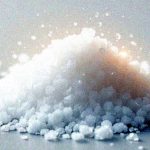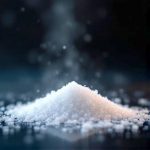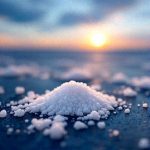Takeaways
- Sodium is essential for electrolyte balance and bodily functions
- Proper sodium intake supports hydration and athletic performance
- Balanced sodium consumption helps maintain healthy blood pressure
- Good cholesterol (HDL) protects heart health
- Diet and exercise influence both sodium and cholesterol levels
- Regular monitoring of sodium and cholesterol is important for health
What Is Sodium?
Sodium is a vital mineral that your body requires for proper function.[1] It’s an important part of electrolytes, which help your cells operate smoothly. You can find sodium in common table salt and in various food items.
Your body uses sodium for multiple essential tasks. It plays a role in regulating blood pressure, supporting nerve function, and assisting muscle movement. Additionally, sodium helps maintain the correct balance of fluids in your body.
The majority of sodium intake comes from the salt in our diets.[2] This includes processed foods, meals from restaurants, and the salt you might add at the table. Some sodium also comes from drinking water and other beverages.
Sodium and Electrolyte Balance
Electrolytes are minerals that carry an electrical charge in your blood.[3] They are crucial for many bodily functions. Sodium is a key electrolyte that the body needs to function effectively.
Sodium works alongside other electrolytes to maintain balance within the body. It assists in regulating the water levels inside and outside of your cells. This balance is essential for the healthy operation of your nerves, muscles, and organs.
| Electrolyte | Main Function |
|---|---|
| Sodium | Fluid balance, nerve signals |
| Potassium | Heart rhythm, muscle function |
| Magnesium | Energy production, bone health |
| Calcium | Muscle contraction, blood clotting |
Imbalances in sodium levels can lead to health problems.[4] Too little sodium may cause headaches, confusion, and in serious situations, seizures. Conversely, excessive sodium could elevate your blood pressure and strain the heart.
Sodium’s Role in Hydration
Sodium helps the body retain water.[5] This is why sports drinks often include sodium, to help replenish what’s lost through perspiration.
Sodium is especially important for athletes and active people. During exercise, the body loses sodium through sweat. Replacing this lost sodium is crucial to prevent dehydration and to maintain proper bodily function during physical activity.
Signs that could indicate you need more sodium include:
- Muscle cramps
- Dizziness
- Headache
- Fatigue
To stay hydrated, consume water regularly and eat foods that contain sodium. However, it’s important not to consume excessive amounts, as too much sodium can be harmful. The goal is to find a balance that works for you.
Recommended Sodium Intake
Health professionals recommend that most adults consume less than 2,300 milligrams of sodium daily, roughly equivalent to one teaspoon of table salt.[6] Some individuals might require even less, particularly if they have high blood pressure.
Individual sodium needs can vary based on factors such as overall health, age, and activity level. Athletes and those working in hot environments might need more sodium to compensate for losses through sweat.
| Age Group | Recommended Daily Sodium Intake |
|---|---|
| Adults | Less than 2,300 mg |
| Ages 51+ | Less than 1,500 mg |
| Children | 1,000-1,500 mg (varies by age) |
Consuming too much sodium over time can contribute to elevated blood pressure.[7] This places added stress on your heart and blood vessels. Conversely, insufficient sodium intake may lead to low blood pressure and other health concerns.
Sodium in Food
Many foods naturally contain some sodium; however, the majority of sodium in our diets comes from processed and prepared foods.[8] These items frequently contain more sodium than people might expect.
Examples of processed foods high in sodium include:
- Canned soups
- Deli meats
- Frozen dinners
- Snack foods like chips and pretzels
Sodium can be found in surprising places. Foods such as bread, cheese, and breakfast cereals often contain sodium. Even sweet items like cookies can contain some sodium.
To monitor sodium intake, carefully read food labels. Look for terms like “sodium,” “salt,” and “soda” in the ingredient list. The nutrition facts panel provides the exact amount of sodium per serving.
Low-Sodium Diets
Certain individuals need to restrict sodium intake for health reasons. This is particularly relevant for those with high blood pressure, heart disease, or kidney issues. A low-sodium diet often involves consuming less than 1,500 mg of sodium per day.
Adopting a low-sodium diet can initially be difficult. Many common foods have a high sodium content. However, with some adjustments, it is possible to reduce sodium intake while still enjoying meals.
Reducing sodium intake does not mean food has to be bland. You can use herbs, spices, and citrus to add flavor without adding sodium. Preparing meals at home also allows greater control over the amount of sodium in your food.
Here are some steps to reduce sodium in your diet:
- Choose fresh or frozen vegetables instead of canned
- Look for “low sodium” or “no salt added” labels
- Rinse canned foods to remove extra sodium
- Use herbs and spices to flavor food instead of salt
- Limit processed and restaurant foods
Sodium and Blood Pressure
The amount of sodium consumed directly impacts blood pressure.[9] When you eat a lot of sodium, your body retains more water. This extra fluid increases the volume of blood in your vessels, which subsequently increases blood pressure.
High blood pressure, also known as hypertension, is a significant risk factor for heart disease and stroke. Reducing sodium intake can often lower blood pressure, particularly in people who are sensitive to salt.[10]
Recent research shows that the relationship between sodium and blood pressure varies among individuals. Some are more affected by sodium intake than others. However, for many, reducing sodium intake can be beneficial for blood pressure management.
To manage blood pressure through sodium intake:
- Monitor your sodium consumption
- Gradually reduce sodium in your diet
- Increase potassium-rich foods like fruits and vegetables
- Stay physically active
Cholesterol: An Introduction
Cholesterol is a waxy substance found in your blood.[11] Your body requires some cholesterol to build healthy cells. However, too much cholesterol can elevate the risk of heart disease.
There are two main types of cholesterol: LDL (low-density lipoprotein) and HDL (high-density lipoprotein). LDL is often referred to as “bad” cholesterol because it can accumulate in your arteries, while HDL is known as “good” cholesterol because it helps remove other cholesterol types from the bloodstream.[12]
Your body naturally produces all the cholesterol it needs.[13] You also get cholesterol from certain foods, mostly animal products. Eating excessive saturated and trans fats may cause your liver to produce more cholesterol than your body needs.[14]
Good Cholesterol (HDL)
High-density lipoprotein (HDL) is recognized as “good” cholesterol. It helps protect your heart by removing other cholesterol forms from your bloodstream. HDL transports cholesterol from your blood vessels back to your liver, where it can be processed and removed from the body.
Higher levels of HDL cholesterol can decrease the risk of heart disease and stroke.[15] HDL may also have other benefits, such as reducing inflammation throughout the body.
You can increase your HDL levels by:
- Exercising regularly
- Maintaining a healthy weight
- Choosing healthy fats like olive oil and avocados
- Quitting smoking
Studies indicate that people with higher HDL levels tend to have better heart health. However, very high HDL levels do not seem to provide additional protection. The objective is to have an overall balanced cholesterol profile.
Managing Cholesterol Levels
Maintaining your cholesterol levels is crucial for overall health. Your diet, physical activity, and genetics all influence cholesterol levels.
Your diet has a large impact on cholesterol.[16] Foods high in saturated and trans fats can increase LDL (bad) cholesterol, while foods rich in fiber and healthy fats may improve your cholesterol profile.
Lifestyle changes to improve cholesterol include:
- Eat a heart-healthy diet
- Exercise regularly
- Maintain a healthy weight
- Limit alcohol consumption
- Quit smoking
For some individuals, lifestyle modifications are not enough to reach healthy cholesterol levels. In such cases, doctors might prescribe medication. Statins are a common type of medication used to lower cholesterol.[17] Consult your doctor before starting any new medication.
Cholesterol and Heart Health
Cholesterol plays a key role in heart health. When excessive LDL cholesterol accumulates in arteries, it can form plaque. This plaque can narrow the arteries and increase the risk of heart disease and stroke.
High cholesterol usually does not cause symptoms, which is why regular cholesterol checks are important.[18] Your doctor can help you understand your risk and take steps to protect your heart.
| Total Cholesterol Level | Category |
|---|---|
| Less than 200 mg/dL | Desirable |
| 200-239 mg/dL | Borderline high |
| 240 mg/dL and above | High |
To maintain a healthy heart, aim for low LDL levels and high HDL levels. A balanced diet, regular exercise, and avoiding smoking are good starting points. If you have other heart disease risk factors, your doctor may suggest more aggressive treatment.
Dietary Sources of Cholesterol
Your body makes most of the cholesterol it needs, but you also get it from some foods. Only animal products contain cholesterol, plant foods do not, even if they have high fat content.[19]
It is important to note that dietary cholesterol does not affect blood cholesterol levels the same way for everyone. For most people, eating foods high in saturated and trans fats has a greater impact on blood cholesterol than eating foods rich in cholesterol itself.[20]
Foods high in cholesterol include:
- Egg yolks
- Shellfish
- Organ meats
- Full-fat dairy products
If you are trying to lower your cholesterol, focus on reducing saturated and trans fats. Choose lean proteins, whole grains, fruits, and vegetables. Plant-based proteins such as beans and lentils are good cholesterol-free options.
Exercise and Cholesterol
Regular physical activity is beneficial for cholesterol levels.[21] Exercise can raise HDL (good) cholesterol and lower LDL (bad) cholesterol. Additionally, it can help maintain a healthy weight, which is also important for heart health.
Aerobic exercise, such as walking, jogging, or cycling, is especially good for your cholesterol. It can help improve overall cardiovascular health. Strength training is also beneficial as it helps to build muscle and boost metabolism.
Steps to incorporate exercise into your routine:
- Start slowly and gradually increase intensity
- Aim for at least 30 minutes of moderate exercise most days
- Choose activities you enjoy to stay motivated
- Mix up your routine with different types of exercise
- Stay consistent for the best results
For optimal benefits, aim for 150 minutes of moderate-intensity exercise or 75 minutes of vigorous exercise weekly. Remember that any amount of exercise is beneficial. Small increases in activity can improve your cholesterol.
Sodium and Cholesterol Interaction
Although sodium and cholesterol are distinct substances, they both impact heart health. High sodium intake can lead to high blood pressure, which can damage blood vessels, making it easier for cholesterol to build up in your arteries.
Sodium does not directly affect cholesterol.[22] However, diets high in sodium often tend to also be high in saturated fats and calories. These dietary factors can elevate cholesterol levels and increase the risk of heart disease.
Balancing sodium and cholesterol for good health involves making wise food choices. Opt for fresh, whole foods over processed ones. This helps to control sodium intake while also providing nutrients that support healthy cholesterol levels.
Myths and Facts
There are many misunderstandings about sodium and cholesterol. Let’s address some of the common ones:
Myth: All salt is bad for you. Fact: Your body needs some sodium to function. The goal is to consume a healthy amount, not eliminate it completely.
Myth: Sea salt is healthier than table salt. Fact: Sea salt and table salt have about the same amount of sodium by weight.[30] [23]
Myth: Only older people need to worry about cholesterol. Fact: Cholesterol can be a problem at any age. It’s never too early to start taking care of your heart health.
Myth: If you eat cholesterol-free foods, you won’t have high cholesterol.[24]
Fact: Your body makes most of the cholesterol in your blood. Saturated and trans fats in your diet influence your cholesterol levels more than dietary cholesterol.
Myth: You can feel it when you have high cholesterol.[25]
Fact: High cholesterol usually doesn’t cause symptoms. Regular check-ups are the best way to know your levels.
Understanding these facts can assist you in making better choices for your health. Always rely on scientific evidence and advice from healthcare professionals when making decisions about your diet and health.
Monitoring Sodium and Cholesterol
Regular check-ups are important for monitoring sodium and cholesterol levels.[26] Your doctor can order blood tests to check your cholesterol and electrolyte levels, including sodium.
When receiving your cholesterol results, you’ll see figures for total cholesterol, LDL, HDL, and triglycerides. Your doctor can clarify what these numbers mean for your health.
Steps to track sodium intake and cholesterol levels at home:
- Keep a food diary to monitor sodium intake
- Use a blood pressure monitor to track changes
- Get regular cholesterol screenings as recommended by your doctor
- Learn to read food labels for sodium and fat content
- Use online tools or apps to track your diet and exercise
Home monitoring is useful, but it should not replace regular check-ups with your doctor. Home monitoring can help you stay on track between visits and make informed choices about your health.
Special Considerations
Different groups of people may have varied needs when it comes to sodium and cholesterol. For instance, older adults may need to be more cautious about sodium because blood pressure often increases with age.
Pregnant women must balance getting adequate sodium with avoiding excessive amounts. The same applies to children, whose sodium needs vary as they grow. Always consult with a healthcare provider for personalized advice.
Genetics play a role in how your body processes sodium and cholesterol. Some people are more sensitive to sodium’s effects on blood pressure.[27] Others might have inherited high cholesterol that is harder to control with diet alone.
If you have a health condition like kidney disease or heart failure, you might need to be extra careful about your sodium intake. Your doctor can help you create a plan that suits your specific situation.
FAQs
How much sodium should I consume daily?
Can I eat eggs if I have high cholesterol?
Does sea salt have less sodium than table salt?
What’s the difference between dietary cholesterol and blood cholesterol?
How quickly can I lower my cholesterol through diet?
Is all sodium bad for you?
Can you have high cholesterol even if you’re thin?
Does stress affect cholesterol levels?
Sodium is crucial for maintaining fluid balance, nerve function, and muscle contractions.
This includes salt added to processed foods, restaurant meals, and during home cooking.
These charged minerals are crucial for nerve and muscle function and overall fluid balance.
Low sodium (hyponatremia) can lead to headaches and seizures, while high sodium (hypernatremia) can cause elevated blood pressure.
This is a critical function of sodium in maintaining fluid balance and blood pressure.
This is the general recommendation, with some individuals needing even less, particularly if they have high blood pressure. This is roughly equivalent to one teaspoon of table salt.
Excess sodium causes the body to retain water, which in turn increases blood volume and blood pressure.
While some sodium is naturally present in foods, most dietary sodium is from added salt in processed items.
Excess sodium leads to water retention, increasing blood volume, and subsequently, blood pressure.
This is especially true for those who are salt-sensitive and at risk for hypertension.
Source: “Effects of low sodium diet versus high sodium diet on blood pressure, renin, aldosterone, catecholamines, cholesterol, and triglyceride” https://www.ncbi.nlm.nih.gov/pmc/articles/PMC8094404/
Cholesterol is a type of lipid that is essential for building cells but can become problematic at elevated levels.
LDL contributes to plaque buildup in arteries, while HDL helps transport cholesterol away from them to the liver for processing.
The liver is the primary site for cholesterol synthesis. Cholesterol in food has much less impact on blood cholesterol than saturated and trans fats.
These fats prompt the liver to produce more LDL cholesterol, which can increase the risk of heart disease.
HDL helps to remove excess cholesterol from the arteries, reducing the risk of plaque buildup.
Source: “Interactive effect of increased high sensitive C-reactive protein and dyslipidemia on cardiovascular diseases: a 12-year prospective cohort study” https://www.ncbi.nlm.nih.gov/pmc/articles/PMC10318784/
Saturated and trans fats can increase LDL cholesterol, while soluble fiber and unsaturated fats can improve the lipid profile.
Statins work by inhibiting the production of cholesterol in the liver.
Because there are typically no signs, regular blood tests are needed to check cholesterol levels.
Plant-based foods, even those high in fat, do not contain cholesterol.
Dietary cholesterol does impact blood cholesterol but generally to a lesser extent than saturated and trans fats. Saturated and trans fats stimulate cholesterol production in the liver.
Physical activity can help lower LDL cholesterol and increase HDL cholesterol.
Sodium and cholesterol are separate substances, and sodium consumption does not directly change cholesterol levels. However, diets high in sodium can sometimes also be high in fats which impact cholesterol.
While there may be some differences in mineral content and taste, the sodium content of sea salt and table salt is largely the same.
Your body produces most of the cholesterol. Saturated and trans fats have a bigger impact than dietary cholesterol.
There are usually no noticeable symptoms of high cholesterol, which is why regular blood tests are important.
Blood tests can assess these levels, helping to manage risk factors for cardiovascular disease.
Genetics and other factors may play a role in how much sodium affects an individual’s blood pressure.
This is the generally accepted limit, with some groups needing lower amounts.
Dietary cholesterol in eggs doesn’t affect blood cholesterol levels as much as previously thought. Moderation is key.
The difference between them lies mainly in taste and mineral content rather than in sodium amount.
Dietary cholesterol is what you consume in foods, whereas blood cholesterol is produced by the body. They are related because food choices can influence blood cholesterol levels.
Initial improvements in cholesterol can occur within a few weeks of dietary changes, but the full effect often takes about three months. This depends on various factors like diet and exercise.
Sodium is essential for bodily functions, and the goal is to consume a balanced amount, not eliminate it entirely.
Factors such as diet, exercise, genetics, and age all influence cholesterol levels, not just weight.
Stress may lead to behaviors that affect cholesterol, such as unhealthy eating habits or lack of exercise.



